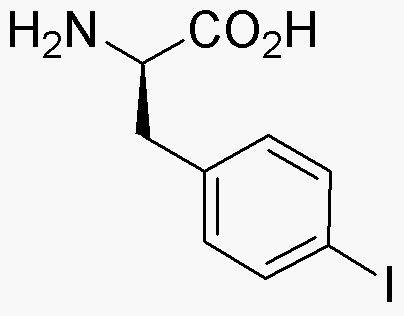D-4-Iodophenylalanine is widely utilized in research focused on:
- Biomedical Research: This compound serves as a valuable tool in studying protein interactions and functions, particularly in the context of receptor binding and signaling pathways.
- Drug Development: It is used in the design of novel pharmaceuticals, especially in targeting specific proteins involved in disease mechanisms, enhancing the efficacy of drug candidates.
- Radiolabeling: The iodine component allows for effective radiolabeling, making it useful in imaging studies and tracking biological processes in vivo.
- Neuroscience Studies: Researchers employ this compound to investigate neurotransmitter systems, contributing to a better understanding of neurological disorders.
- Protein Engineering: It aids in the development of modified proteins with enhanced properties, which can be applied in various biotechnological applications.
General Information
Properties
Safety and Regulations
Applications
D-4-Iodophenylalanine is widely utilized in research focused on:
- Biomedical Research: This compound serves as a valuable tool in studying protein interactions and functions, particularly in the context of receptor binding and signaling pathways.
- Drug Development: It is used in the design of novel pharmaceuticals, especially in targeting specific proteins involved in disease mechanisms, enhancing the efficacy of drug candidates.
- Radiolabeling: The iodine component allows for effective radiolabeling, making it useful in imaging studies and tracking biological processes in vivo.
- Neuroscience Studies: Researchers employ this compound to investigate neurotransmitter systems, contributing to a better understanding of neurological disorders.
- Protein Engineering: It aids in the development of modified proteins with enhanced properties, which can be applied in various biotechnological applications.
Documents
Safety Data Sheets (SDS)
The SDS provides comprehensive safety information on handling, storage, and disposal of the product.
Product Specification (PS)
The PS provides a comprehensive breakdown of the product’s properties, including chemical composition, physical state, purity, and storage requirements. It also details acceptable quality ranges and the product's intended applications.
Certificates of Analysis (COA)
Search for Certificates of Analysis (COA) by entering the products Lot Number. Lot and Batch Numbers can be found on a product’s label following the words ‘Lot’ or ‘Batch’.
*Catalog Number
*Lot Number
Certificates Of Origin (COO)
This COO confirms the country where the product was manufactured, and also details the materials and components used in it and whether it is derived from natural, synthetic, or other specific sources. This certificate may be required for customs, trade, and regulatory compliance.
*Catalog Number
*Lot Number
Safety Data Sheets (SDS)
The SDS provides comprehensive safety information on handling, storage, and disposal of the product.
DownloadProduct Specification (PS)
The PS provides a comprehensive breakdown of the product’s properties, including chemical composition, physical state, purity, and storage requirements. It also details acceptable quality ranges and the product's intended applications.
DownloadCertificates of Analysis (COA)
Search for Certificates of Analysis (COA) by entering the products Lot Number. Lot and Batch Numbers can be found on a product’s label following the words ‘Lot’ or ‘Batch’.
*Catalog Number
*Lot Number
Certificates Of Origin (COO)
This COO confirms the country where the product was manufactured, and also details the materials and components used in it and whether it is derived from natural, synthetic, or other specific sources. This certificate may be required for customs, trade, and regulatory compliance.


